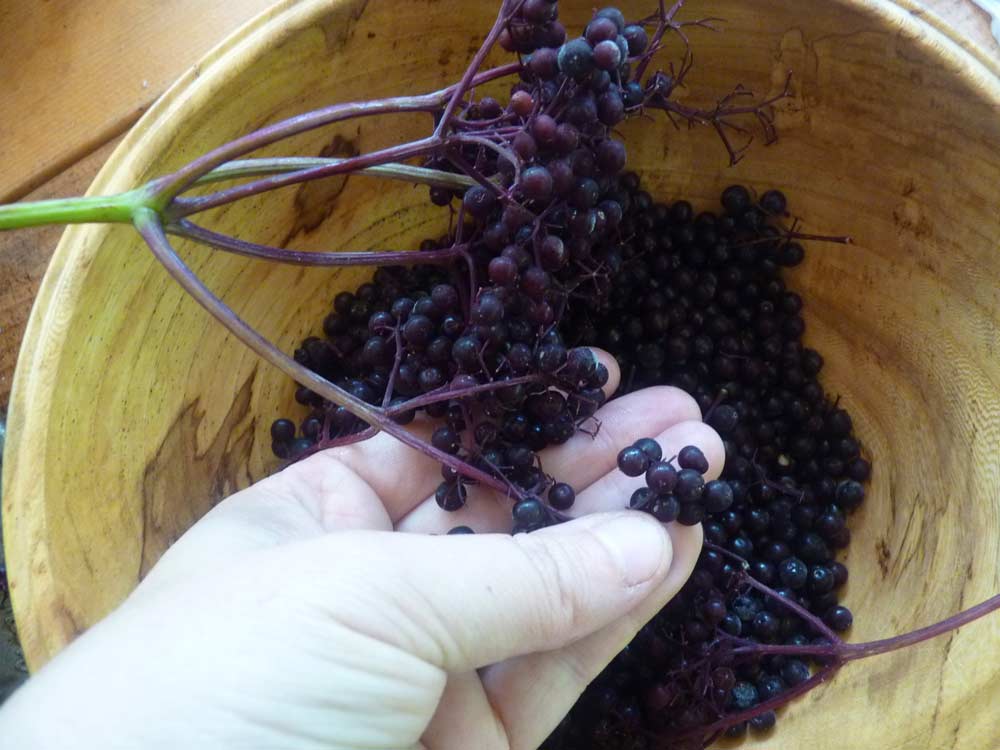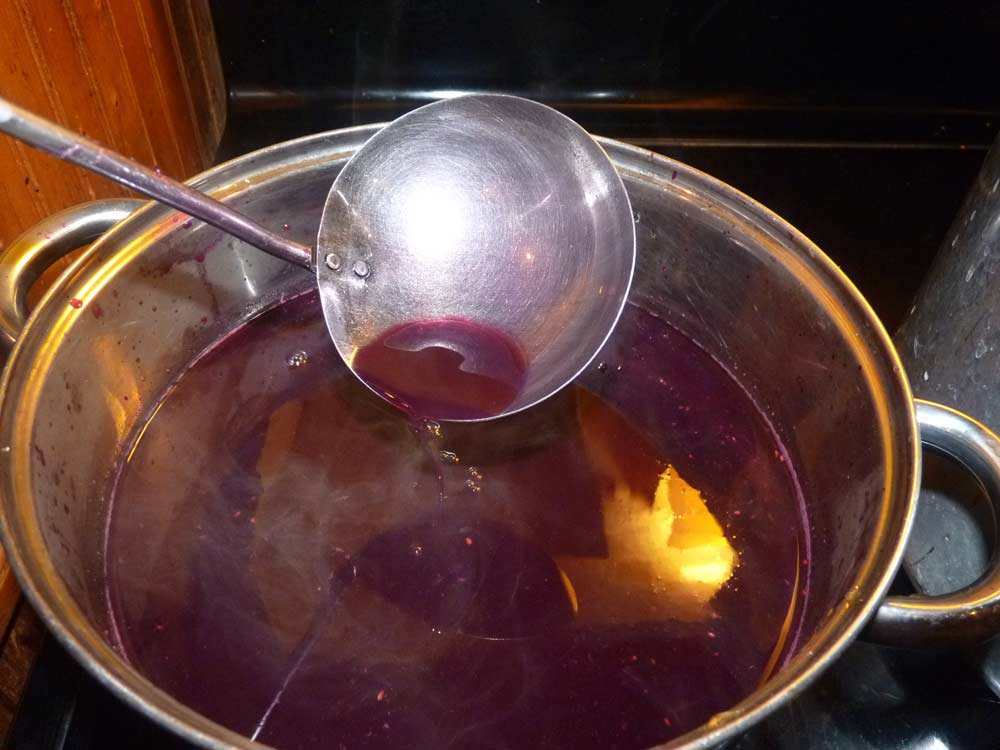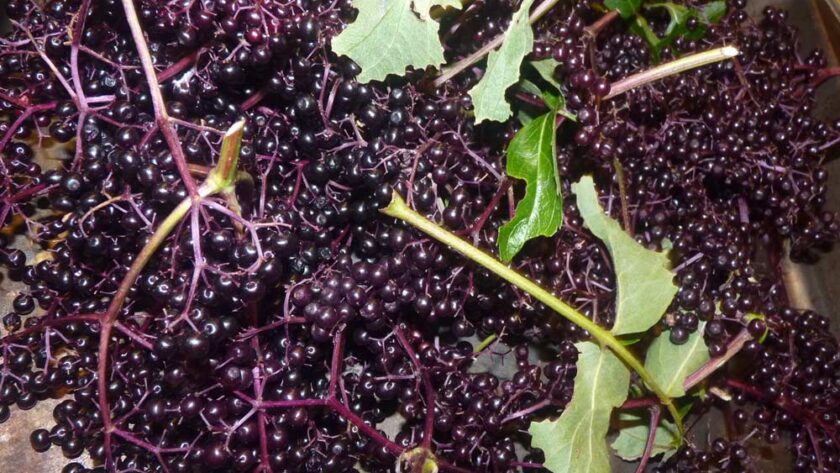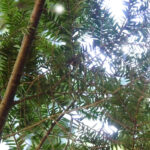It is that delightful time of year again, when the berries of the fall ripen, when the pumpkins grow orange on their vines, and when the elders are literally loaded with berries. The elderberry tree is a fascinating plant, rich with mythology and magic. The word “elder” of course has multiple meanings, but I like to think of this plant as my elder in a literal sense, that I can sit at the feet of the elderberry tree and learn much from her wisdom. We were blessed this year with a bumper crop of these delightful elderberries, and I set to work making a medicinal syrup (I like to call it Elderberry Elixir) to aid in immune system support for the winter. Last year when I made this syrup in September it went bad by the time January rolled around, so this year I got smart and decided to can it for longer-term storage.
You can make this recipe with dried berries instead of fresh ones. Fresh elderberries have been reported by some to cause an upset stomach, but when you dry them or cook them they are perfectly fine and highly medicinal.

My herb teacher, Jim McDonald, taught me that Elder is particularly useful for the kind of immune system support one needs to prevent viruses from replicating throughout our bodies–the elder provides support to block that kind of replication. It has a host of other health benefits, such as a high amount of flavenoids and for general support for colds, reducing the amount of time one needs to get through the sickness. This Elderberry Elixir is a great and tasty way to take such medicine. Jim has a fantastic write-up on elder (both flowers and berries) on his site that I highly recommend you read! Grieve’s herbal has a complete listing for elder online here.
One of the reasons I prefer to pick my own berries is that it allows me to develop a relationship, hopefully over a period of years with many visits, with the elder as a species but also as an individual tree. Learning to find your own medicine if you are able, and spending time just sitting with those trees, seeing how they grow, picking their fruit, and giving thanks, perhaps leaving an offering, is a critical part of herbal practice. The plants are our teachers, our allies, and they respond better to us when we establish a relationship. I kinda see it as the difference between having a conversation with a stranger vs. a very close friend–if you end up having a 20 min conversation with someone you just meet, you might have a good conversation, get to know the person a bit, learn a bit about their life. But if you ended up having that same 20 min conversation with a person you knew well, that conversation would be much different, likely much deeper. Working with the plants themselves is a lot like that–the stronger of a connection you develop with a particular plant species over time, the more effective of a medicine it is going to be for you. Elder is one of those plants that is quite abundant throughout most of the US, and its worth seeing her out and sitting at her roots and learning from her. She has powerful, potent medicine for us, and many other lessons to teach as well.
Elderberry Elixir
Ingredients:
Fresh or dried elderberries (you can get dried ones from Mt. Rose Herbs). The recipe is based on ratios, so you can get as many as you want of these. I prefer the fresh, but not everyone can get to them.
Fresh ginger, 1 TBSP per cup of fresh berries / per 1/2 cup dried berries
Cloves, 1/4 teaspoon per cup of berries / per 1/2 cup dried berries
Cinnamon: 1-2 teaspoons per cup of berries (depending on your taste) / per 1/2 cup dried berries
Honey: 1/2 cup per cup of berries / per 1/4 cup dried berries
Water enough to cover the berries
Instructions
1. Remove your berries. You will have bunches and bunches of awesome elderberries after you go picking (or you will have the dried ones ready to go). One of the best ways to remove elder is to start by freezing the berries. If you freeze them, they will come off super easily, and freezing will save you a lot of processing time.

2. Measure your berries and add water to cover. Measure out your berries and add an appropriate amount of water to cover them up.
3. Prepare your other ingredients (except honey, which comes later). You will want to chop your ginger very fine. You can use whole cinnamon sticks and cloves if you want as everything will be strained. I like the powders because I think I get a better extraction that way. Add your ingredients to the pot.


4. Mash up your berries and simmer your ingredients for 1-2 hours. The longer you simmer your ingredients, the better extraction you’ll get of everything. I like to cook this a minimum of two hours. After you’ve cooked it that long, let it cool on the stove for a while (likely another 30 min to an hour).


5. After it cools, use a strainer to strain out the seeds, cloves, ginger and other “hard” materials. If you are canning it, you don’t want to let it get too cool.

6. Add honey. Add your honey to the syrup at this point. You can also choose to add honey to taste later in the process if you are using raw honey and want to preserve its natural enzymes. I added my honey and then canned it, so I did lose some of the raw honey benefits, but my syrup will stay good for a very long time, so I decided the trade-off was worth it. I could have canned or froze it without the honey, and added it in as I was taking it.
7. Select a preservation method. I chose to hot water bath my elixir, mainly because when I made this last year at this time, I just stuck it in the fridge and then when I really needed it, it had gone moldy. It will keep in the fridge for about 3 months, but that isn’t going to get you through the whole year till the elderberries are in season again. So I would suggest either canning it or freezing it. I chose to hot water bath can it–I followed instructions online for canning elderberry juice (1/4 headspace; 15-minute hot water bath processing time). The elders are very tart and contain a lot of acid, so the recipe is a safe one for hot water bath canning.

There you have it–a powerful medicine from a wonderful plant ally. In terms of dosage, you want to take 1-2 tbsp of this a day; even more if you feel sickness coming on. Its not “medicine” in the traditional pharmaceutical sense, so you can take a lot if you’d like. I usually stick to the 1-2 tbsp per day and find that works quite well for me!




There is a woman who makes elderberry syrup and sells it at the farmer’s market in my hometown! I’ve used it for years and it really does work! It would be great to make some myself but like many other things, I can’t seem to make it a priority with my life where it is right now (working grad student and my home is a very small condo with no yard at all). But! At least in this case, since the “Elderberry Lady” (as we’ve come to call her) lives in my hometown, I’ve spoken to her and know how she makes her recipe and where she gets her berries, etc., so for now I feel pretty good about it. And it is very yummy! 🙂
I think its wonderful that you support this woman’s local business! And graduate school….I hear you :). Things got a lot better for me after I finished my Ph.D. 😛
What is the recipe the lady in farmers market uses?
Hello Gloria,
Most people use some version of this recipe! You can try it and then try the farmer’s market recipe and tweak as appropriate. For example, someone might add orange peel or nutmeg instead of cinnamon–some people don’t use any spices and use only elder. Its really up to the individual. But this recipe should be a great basis for you!
Looks great sister! 🙂
Thank you, Brie! I have some for you 🙂
Thanks so much for the recipe.
I started using elder berries by accident. I learn to prepare mermelades with a book, and once I saw this beatiful berries in a Elder tree, in Spanish this is call “sauco” and is very common in my Country, Colombia. So, I started using first the flowers to prepare tea for cough, and I found out that this flower rise the inmune system, true, I rarely have colds. So comming back to the story, I was looking for different type of ingredients for mermelades so I took these berries with a little afraid because I though! What if they are poisonuos?, still I prepare the mermelade, this get thick really fast, must to be for some component that it has. So the first one got very… sticky almost like hard candy, next get better. As far as I din´t poison myself, because I tryed first, I started to giving it to friends and family. Must of people like it. My niece ended loving it. She ask for her mermalade periodically.
Now with this new recipe for a useful syrup, If God aloow me to do it, I will prepare it as soon we have a harvest of berries over here, which happens I think like 4 times per year. Bye.
Hehe, that’s one way to discover wild foods! To avoid eating the wrong berries, you might check out Samuel Thayer’s two books on foraging: The Forager’s Harvest and Nature’s Garden. They are fantastic books and will teach you many things. There might be books better suited to your region, however. Thanks for commenting!
Have you tried freezing this? My apartment has a small, flat topped stove that is unsafe to can on.
I actually can all the time on a flat topped electric stove :). But yes, you can totally freeze this. I froze some last year.
Thank you for the info.
I’ve got a recipe for this I’ve been meaning to try – thanks for reminding me! Yours looks great for a large batch! I definitely want to try this soon.
What is the shelf life one it is preserved?
Usually about 2-3 years :). I have some from 2016 that are still good!
Thank you so much for this recipe I cannot wait to try i had a question on about how much does this recipe make?
This is a ratio recipe, so it depends on how many berries you have harvested or plan on using. Pretty much however much water you put in to cover the berries is the approximate yield.